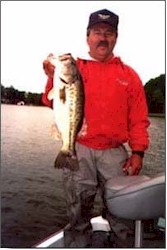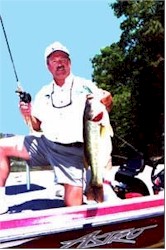Proven Winners!
<SMALL><SMALL><SMALL>by Alan Paczkowski</SMALL></SMALL></SMALL>
 <B><BIG>Some are big. Some are small. </BIG></B>Some float. Some do not. They come in many different sizes and shapes. Depth is an important factor; but do not assume that a deep one is better than a shallow one.
<B><BIG>Some are big. Some are small. </BIG></B>Some float. Some do not. They come in many different sizes and shapes. Depth is an important factor; but do not assume that a deep one is better than a shallow one.
If you think I am talking about baits then guess again. Give up? Okay, what I am referring to are docks; the one predominant man-made feature which is common to just about every lake or reservoir.
<B><BIG>Ideal cover.</BIG></B> To a bass angler docks represent an ideal form of cover. Why? Because they provide overhead cover, shade, and structure. Even more importantly they attract bluegills, crappies and other natural forage. Given those attributes it would be unnatural for bass not to live around them. So as not to confuse you; when I use the term docks I am referring to the family of man-made structures which include boatdocks, boathouses, and piers.
 No doubt docks provide excellent ambush sites for bass to operate from. Yet all docks do not attract or hold bass. Why? Because all are not created equal!
No doubt docks provide excellent ambush sites for bass to operate from. Yet all docks do not attract or hold bass. Why? Because all are not created equal!
<BIG>The secret is...SHADE.</BIG> Many hours of on the water trial and error, have taught me that one factor is predominant in selecting which man-made features attract and hold bass better than others. That factor is SHADE. Little doubt, shade is the key to locating bass around man-made features. Simply put, good docks provide ample shade; poor docks offer little shade.
Additionally, prime docks for bass fishing lie close to the water and cast dark shadows which give bass a distinct visibility advantage over prey which swim by them in the unshaded water. I have also found that the best docks extend from the shore to depths of 4 to 6 feet; depths which are heavily used by bass while feeding. Furthermore, docks which lie adjacent to weed flats or weed lines tend to be more productive. Bass love to move in from nearby weed-beds at prime times, usually around mid-day, and use docks as a major part of their feeding ritual.
<BIG>The ideal dock.</BIG> Sure you say, but with so many "ideal" docks to choose from, how does one go about deciding which docks to fish and which one's not to bother with. A valid question and one not easily answered since even docks with similar characteristics do not always attract and hold bass. So here are a few simple guidelines I use to help identify what I believe are the docks with the most bass "catching" potential:
Suffice it to say, if dock fishing is not part of your repertoire, it should be. Here are a few simple approaches you can use to get started:
Till next time, have fun fishing, be safe and courteous on the water, and please practice catch and release so we all can enjoy bass fishing for many years to come.
<SMALL><SMALL><SMALL>by Alan Paczkowski</SMALL></SMALL></SMALL>

If you think I am talking about baits then guess again. Give up? Okay, what I am referring to are docks; the one predominant man-made feature which is common to just about every lake or reservoir.
<B><BIG>Ideal cover.</BIG></B> To a bass angler docks represent an ideal form of cover. Why? Because they provide overhead cover, shade, and structure. Even more importantly they attract bluegills, crappies and other natural forage. Given those attributes it would be unnatural for bass not to live around them. So as not to confuse you; when I use the term docks I am referring to the family of man-made structures which include boatdocks, boathouses, and piers.

<BIG>The secret is...SHADE.</BIG> Many hours of on the water trial and error, have taught me that one factor is predominant in selecting which man-made features attract and hold bass better than others. That factor is SHADE. Little doubt, shade is the key to locating bass around man-made features. Simply put, good docks provide ample shade; poor docks offer little shade.
Additionally, prime docks for bass fishing lie close to the water and cast dark shadows which give bass a distinct visibility advantage over prey which swim by them in the unshaded water. I have also found that the best docks extend from the shore to depths of 4 to 6 feet; depths which are heavily used by bass while feeding. Furthermore, docks which lie adjacent to weed flats or weed lines tend to be more productive. Bass love to move in from nearby weed-beds at prime times, usually around mid-day, and use docks as a major part of their feeding ritual.
<BIG>The ideal dock.</BIG> Sure you say, but with so many "ideal" docks to choose from, how does one go about deciding which docks to fish and which one's not to bother with. A valid question and one not easily answered since even docks with similar characteristics do not always attract and hold bass. So here are a few simple guidelines I use to help identify what I believe are the docks with the most bass "catching" potential:
- Docks with wood pilings are better than those with metal pilings.
- Fixed docks are better than floating docks in that they provide both vertical and horizontal structure.
- Docks which are low to the water offer better overhead cover than docks which are high off the water.
- Big docks are better than small docks.
- Irregular shaped docks ("T" or "L") are better than symmetrical ones.
- Docks with tight decking are better than those with wide cracks or openings in-between the decking.
- Lastly, docks located near weeds are usually better than those located in clear areas, sand, or shallow vegetation.
Suffice it to say, if dock fishing is not part of your repertoire, it should be. Here are a few simple approaches you can use to get started:
- <BIG>Run the outside edges.</BIG> Remember that aggressive bass will be out on the outside edges of docks poised and ready to give chase to unsuspecting forage. To catch these bass, approach docks cautiously and throw a spinnerbait, topwater bait, stickbait, or crankbait right along the dock edge; especially on the shady side.
- <BIG><B>Flip the pilings and corners.<BIG> </BIG></B></BIG>Less aggressive bass present more of a challenge since they are reluctant to give chase to forage (or your bait). To entice these bass flipping is the preferred technique. With some practice you will soon be able to place a jig or soft plastic bait with pinpoint accuracy along dock pilings and in corners where bass prefer to hold.
- <B><BIG>Skip well under the dock.</BIG></B> Lastly, and probably one of the most effective ways to work docks is by "skipping" lightly weighted worms, lizards, grubs, flukes, or tube jigs well under a dock. I prefer a spinning outfit when "skipping" since it is less likely to back-lash and allows the bait to fall straight down when it enters the water. Effective "skipping" requires a lot of practice and patience. The cast must be flat and powerful enough to "skip" your bait across the water several times and achieve the required distance under the dock. I find a slight upswing at the moment of release tends to help. Just like learning to cleanly skip a rock across the water took time so will learning to perfect this technique.
Till next time, have fun fishing, be safe and courteous on the water, and please practice catch and release so we all can enjoy bass fishing for many years to come.

